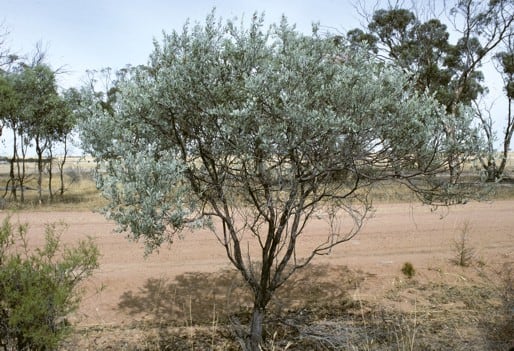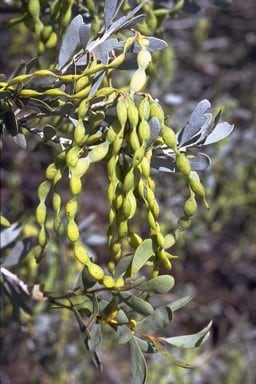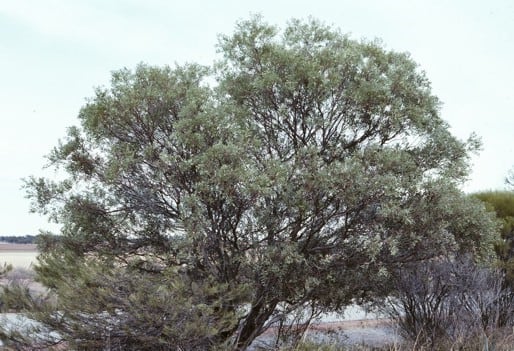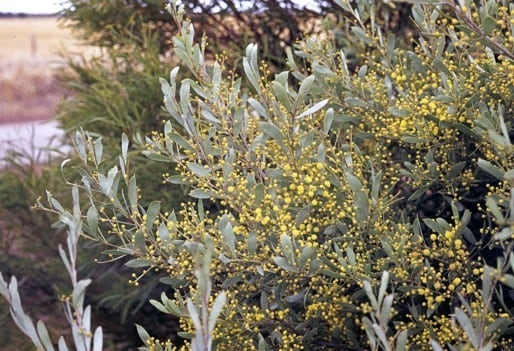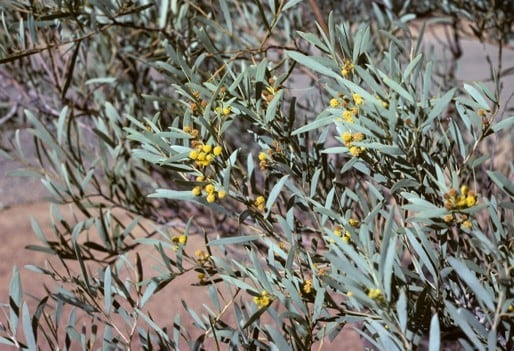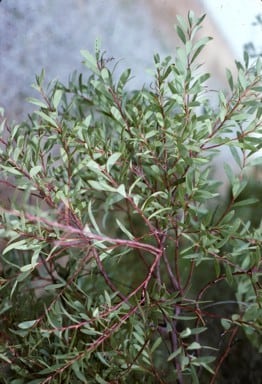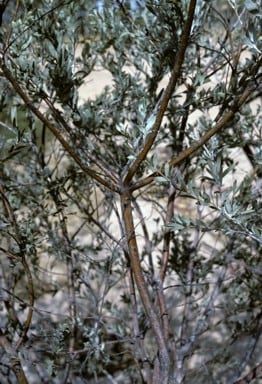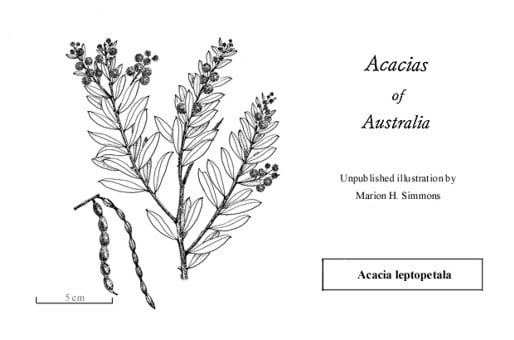Acacia leptopetala Benth.
WATTLE
Acacias of Australia
Family
Fabaceae
Distribution
Occurs from near Bencubbin S to Nyabing and E to near Ravensthorpe, south-western W.A.
Description
Commonly a dense and multistemmed, glabrous shrub 2–3 m high. Branchlets sometimes pruinose. Phyllodes usually narrowly elliptic to narrowly oblanceolate, sometimes recurved, 2–5.5 (–6.7) cm long, 3–11 (–20) mm wide, l:w = 3–9, acute to obtuse or acuminate, frequently subuncinate, thinly coriaceous, ±glaucous, with raised midrib, finely penninerved; gland inconspicuous, usually 5–20 mm above pulvinus. Inflorescences mostly 3–6-headed racemes, sometimes a few simple; raceme axes (0.5–) 1–3 (–4.5) cm long; peduncles 3–8 (-15) mm long; heads globular, 3.5–4 mm diam., 25–35-flowered, light golden. Flowers 5-merous; sepals free. Pods linear, rounded over seeds and usually ±constricted between them, to 9.5 cm long, 4.5–6 mm wide, thinly coriaceous to slightly crustaceous, often slightly pruinose, glabrous. Seeds longitudinal, ovate, oblong or elliptic, usually 5–6 mm long, dull, black; funicle filiform, 3/4 to completely encircling seed in 1 or 2 folds, light brown to red-brown; aril thick.
Habitat
Grows in clay, loam, sandy loam, sand and sandy gravel, mostly in flatlands, in mallee scrub.
Specimens
W.A.: near Welbungin, C.A.Gardner 6469 (PERTH); 18 km S of Ravensthorpe towards Hopetoun, B.R.Maslin 3901 (PERTH); c. 4 km due NW of Nalyaring Well, B.R.Maslin 5332 (PERTH); 123 mile peg [c. 5 km] W of Kellerberrin, R.D.Royce 6776 (B, BRI, CANB, G, K, MEL, NSW, NY, PERTH).
Notes
The Oldfield specimen cited by G.Bentham in Fl. Austral. 2: 370 (1864) under A. leptopetala is A. murrayana. This error led G.Bentham, Trans. Linn. Soc. London 30: 472 (1875), and F.J.H. von Mueller, Iconog. Austral. Acacia dec. 5 (1887), to misapply the name A. leptopetala to A. murrayana and J.H.Maiden, J. & Proc. Roy. Soc. New South Wales 49: 495 (1916) to regard the two names as synonymous.
A member of the ‘A. microbotrya group’, closely related to A. meisneri and A. merrickiae. Future studies may show that the three entities are better treated as infraspecific taxa of a single variable species. Presumed hybrids occur between A. leptopetala and A. merrickiae (e.g. B.R.Maslin 594, MEL, NSW, PERTH). Similar to A. chrysella.
A polymorphic species in which meaningful infraspecific taxa cannot be defined at present. Plants with conspicuously pruinose branchlets predominate in the Bungulla–Kellerberrin area and this form is sometimes difficult to distinguish from A. meisneri and A. merrickiae. The type of A. leptopetala appears to be referable to this pruinose form. Plants lacking pruinosity or only slightly pruinose are more common and this form includes the type of A. subglauca. Specimens from the Hopetoun–Ravensthorpe area have ±oblong phyllodes with the gland only 3–4 mm above the pulvinus, pods not or scarcely constricted between the seeds, seeds 4–4.5 mm long, areole open (closed elsewhere) and funicle 1/2 encircling seeds. They resemble A. subcaerulea which is distinguished by its sharply angular branchlets, broadly oblong pods with transverse seeds, and racemes which are subtended by bracts when young.
FOA Reference
Data derived from Flora of Australia Volumes 11A (2001), 11B (2001) and 12 (1998), products of ABRS, ©Commonwealth of Australia
Author
Minor edits by J.Rogers
B.R.Maslin
This identification key and fact sheets are available as a mobile application:
URL: https://apps.lucidcentral.org/wattle/
© Copyright 2018. All rights reserved.
